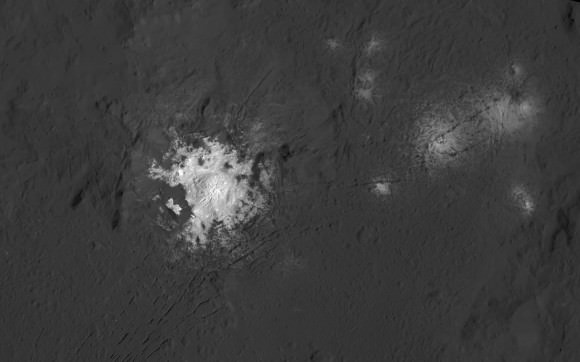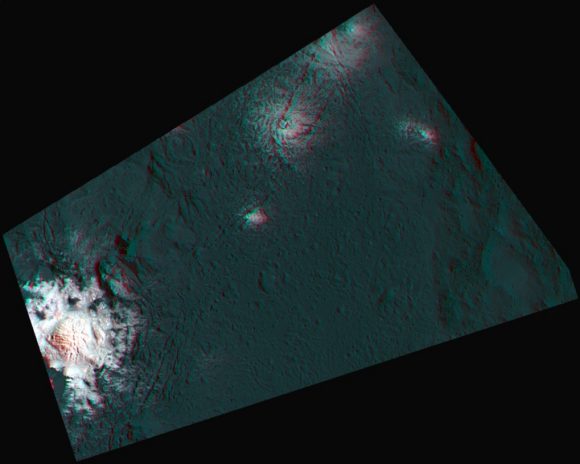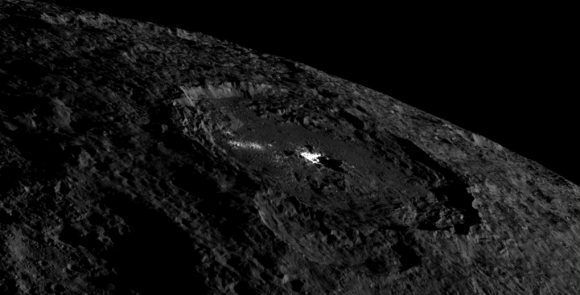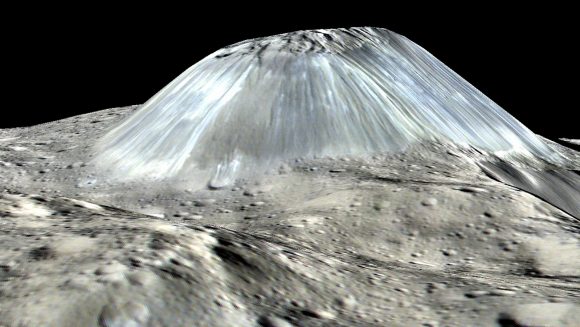The bright regions on the dwarf planet Ceres have been some of the most talked about features in planetary science in recent years. While data from the Dawn spacecraft has shown these bright areas are salt deposits (alas, not lights of an alien city), the question remained of where these salts came from.
Researchers with the Dawn mission say they have now thoroughly investigated the complex geological structures in Occator crater, the region with the brightest regions on Ceres. The scientists conclude that a bright dome-like feature called Cerealia Facula is the remnant of a cryovolcano -- an ice volcano -- that repeatedly and relatively recently spewed salty ice on the surface of Ceres.
"The age and appearance of the material surrounding the bright dome indicate that Cerealia Facula was formed by a recurring, eruptive process, which also hurled material into more outward regions of the central pit," said Andreas Nathues, a Dawn scientist from the Max Planck Institute for Solar System Research. "A single eruptive event is rather unlikely."

The bright central spots near the center of Occator Crater are shown in enhanced color in this view from NASA's Dawn spacecraft. The view was produced by combining the highest resolution images taken in February 2016 (at image scales 115 feet (35 meters) per pixel of 35 meters with color images obtained in September 2015 at a lower resolution. Click for a highest-res view. Credit: NASA/JPL-Caltech/UCLA/MPS/DLR/IDA/PSI
Occator crater located in the northern hemisphere of Ceres measures 92 kilometers (57 miles) in diameter. In its center is a pit with a diameter of about 11 kilometers (7 miles). On some parts of its edges, jagged mountains and steep slopes rise up to 750 meters (820 yards) high. Within the pit a bright dome formed. It has a diameter of 3 km (1.8 miles), is 400 meters (437 yards) high, with prominent fractures.
In analyzing images from Dawn's Framing Camera, Nathues and his team deduced that the central pit is a remnant of a former central mountain, formed from the impact that created Occator Crater about 34 million years ago. But with a method for estimating the age of a planet's surface – called crater counting -- the science team could determine the dome of bright material is only about four million years old.
This suggests, the team said, that Occator crater has been the scene of eruptive outbursts of subsurface brine over a long period and until almost recently.
Jupiter's moons Callisto and Ganymede show similar types of domes, and researchers interpret them as signs of cryovolcanism. While Ceres is too far from the Sun to be warm enough for regular volcanic activity, it very likely has harbored cryovolcanic activity, and it may even be active today.

This 3d-anaglyph for the first time shows a part of Occator crater in a combination of anaglyphe and false-color image. Credit: NASA/JPL-Caltech/UCLA/MPS/DLR/IDA
Images from the Hubble Space Telescope taken more than a decade ago hinted at the bright spots in Occator Crater, but as the Dawn spacecraft approached Ceres in 2015, new images showed the bright areas almost shining like "cosmic beacons, like interplanetary lighthouses drawing us forth," as described by Marc Rayman, the chief engineer and mission director for Dawn, in an interview with me last year.
Dawn scientist had previously determined the bright areas were salts left over from subsurface briny water that had made its way to the surface, and in the vacuum of space, the water sublimated away, leaving behind the dissolved salts. These salts were determined to be sodium carbonate and ammonium chloride.

This view of the whole Occator crater shows the brightly colored pit in its center and the cryovolcanic dome. The jagged mountains on the edge of the pit throw their shadows on parts of the pit. This image was taken from a distance of 1478 kilometers above the surface and has a resolution of 158 meters per pixel. Credit: NASA/JPL-Caltech/UCLA/MPS/DLR/IDA
But don't call these bright areas "spots," said Rayman. "Some of these bright areas are miles across," he said, "and just as if you were standing on salt flats on Earth that were several thousand acres, you wouldn't say, 'I'm standing on a spot.' You are standing on a big area. But just to see the distribution of this material in the Dawn images shows there is something complex going on there."
It is currently unknown if the region in Occator Crater is active, but there are hints it is, at least at a low level.
In 2014 the Herschel spacecraft detected water vapor above Occator, and images from Dawn's cameras of the crater show a 'haze' when imaged at certain angles, and this has been explained as the sublimation of water.
Dawn scientists are also studying the large volcanic feature on Ceres, Ahuna Mons, to determine if it could be a cryovolcano.

Ceres' lonely mountain, Ahuna Mons, is seen in this simulated perspective view. The elevation has been exaggerated by a factor of two. Image Credit: NASA/JPL-Caltech/UCLA/MPS/DLR/IDA/PSI
Further Reading: Max Planck Institute for Solar System Research
No comments:
Post a Comment